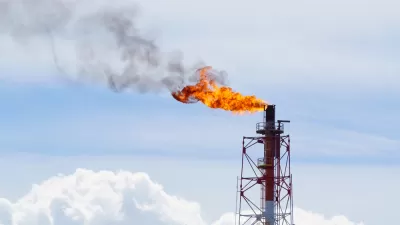Climate change was front and center at a Thursday morning joint press conference at the White House, where U.S. President Barack Obama and Canadian Prime Minister Justin Trudeau agreed to several energy, environmental, and Arctic initiatives.
Both leaders have taken a keen interest in stemming climate change, so the press conference was largely one of like-minded heads of state, a far cry from the relationship that existed between President Obama and Trudeau's predecessor, PM Stephen Harper, that was strained by disagreements over the Keystone XL pipeline.
Perhaps most important among the agreements between Prime Minister Trudeau and Obama was a regulation "to reduce potent methane emissions from the oil and gas industry by 40-45% below 2012 levels by 2025," writes William Yardley who covers energy and environmental issues in the West for the Los Angeles Times.
President Obama announced such a regulation last year and the EPA proposed it last August. That rule would apply to "new and modified oil and gas wells," notes Yardley. "The proposed new policy would apply to existing facilities."
"Trudeau, the moderate son of former Prime Minister Pierre Trudeau, made environmental issues a key part of his 2015 campaign and said that although he supported Keystone XL, he would not allow the debate over it to taint relations between the two countries," writes Yardley. For an informative yet delightful read on Trudeau, see "Justin Trudeau, Canada’s dreamy prime minister, explained for Americans," by Vox writer Zack Beauchamp.
Among the many issues covered in the "U.S.-Canada Joint Statement on Climate, Energy, and Arctic Leadership," "the plan to reduce methane drew by far the most praise and criticism," writes Yardley.
“This ultimately is such a common sense thing to focus on,” Mark Brownstein, vice president for climate and energy at the Environmental Defense Fund, said in an interview on Thursday. “So much of what needs to be done here is better operation and maintenance. This is not expensive to achieve.”
As one would expect, the reaction from the fossil fuel industry was not so kind.
“Additional regulations on methane by the administration could discourage the shale energy revolution that has helped America lead the world in reducing emissions while significantly lowering the costs of energy to consumers,” Kyle Isakower, the vice president of regulatory and economic policy for the American Petroleum Institute, said in a written statement. “The administration is catering to environmental extremists at the expense of American consumers.”
Last word goes to President Obama, who stated at Thursday's news conference in the White House Rose Garden:
“As the first U.S. president to visit the Arctic,” I saw how both of our nations are threatened by rising seas, melting permafrost, disappearing glaciers and sea ice, and so we are focusing on making sure the Paris agreement is fully implemented and we're working to double our investments in clean energy research and development,” he said.
FULL STORY: U.S. and Canada pledge to cut methane emissions as part of broad climate change agreement

Alabama: Trump Terminates Settlements for Black Communities Harmed By Raw Sewage
Trump deemed the landmark civil rights agreement “illegal DEI and environmental justice policy.”

Study: Maui’s Plan to Convert Vacation Rentals to Long-Term Housing Could Cause Nearly $1 Billion Economic Loss
The plan would reduce visitor accommodation by 25% resulting in 1,900 jobs lost.

Why Should We Subsidize Public Transportation?
Many public transit agencies face financial stress due to rising costs, declining fare revenue, and declining subsidies. Transit advocates must provide a strong business case for increasing public transit funding.

Paris Bike Boom Leads to Steep Drop in Air Pollution
The French city’s air quality has improved dramatically in the past 20 years, coinciding with a growth in cycling.

Why Housing Costs More to Build in California Than in Texas
Hard costs like labor and materials combined with ‘soft’ costs such as permitting make building in the San Francisco Bay Area almost three times as costly as in Texas cities.

San Diego County Sees a Rise in Urban Coyotes
San Diego County experiences a rise in urban coyotes, as sightings become prevalent throughout its urban neighbourhoods and surrounding areas.
Urban Design for Planners 1: Software Tools
This six-course series explores essential urban design concepts using open source software and equips planners with the tools they need to participate fully in the urban design process.
Planning for Universal Design
Learn the tools for implementing Universal Design in planning regulations.
Smith Gee Studio
Alamo Area Metropolitan Planning Organization
City of Santa Clarita
Institute for Housing and Urban Development Studies (IHS)
City of Grandview
Harvard GSD Executive Education
Toledo-Lucas County Plan Commissions
Salt Lake City
NYU Wagner Graduate School of Public Service



























